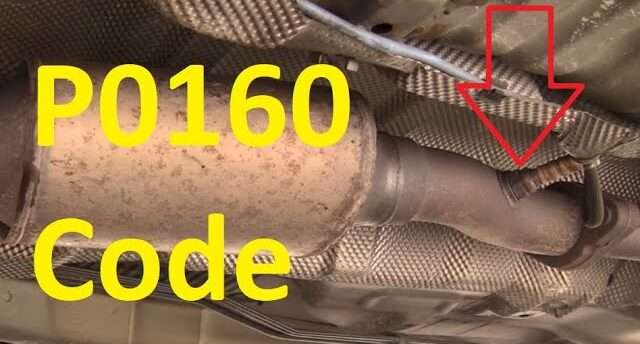
P0160 Oxygen sensor circuit inactivated (sensor 2, bank 2)
Content
P0160 – OBD-II Trouble Code Technical Description
Trouble code P0160 indicates no activity in the oxygen sensor circuit (sensor 2, bank 2)
What does the fault code mean P0160?
Trouble code P0160 indicates a problem with the Oxygen Sensor of Bank 2, Sensor 2 after the catalytic converter. This error code indicates low voltage in the oxygen sensor circuit, which can indicate various problems such as insufficient oxygen in the exhaust gases or a malfunction of the sensor itself.
Oxygen sensor 2 typically monitors the oxygen content of the exhaust gases after the catalyst, and its signals are used to correct engine operation and check the effectiveness of the catalyst.
A P0160 code usually indicates a faulty oxygen sensor, but can also be related to problems with the wiring, connectors, or other electrical components.

Possible reasons
Possible reasons for this DTC P0160 issue:
- Oxygen sensor malfunction: The most common reason. The oxygen sensor can become damaged or fail due to aging, corrosion, mechanical damage or contamination.
- Damaged or broken wiring: Problems with the wiring connecting the oxygen sensor to the engine control module can result in incorrect data transmission or no signal.
- Connector problems: Incorrect connection or corrosion in the oxygen sensor connector may cause communication problems.
- Problems with the catalyst: Damage or malfunction of the catalytic converter may result in incorrect readings from the oxygen sensor.
- Problems with the engine control module (ECM): A malfunction of the engine control module can lead to incorrect interpretation of the signal from the oxygen sensor.
- Problems with the fuel injection system: Improper operation of the fuel injection system may result in uneven mixing of fuel and air, which in turn may affect the performance of the oxygen sensor.
- Problems with the intake system: For example, an intake manifold leak or a problem with the mass air flow sensor (MAF sensor) can affect the performance of the oxygen sensor.
- Problems with the exhaust system: For example, a leak in front of the catalytic converter or damage to the exhaust system may affect the operation of the oxygen sensor.
To accurately determine the cause, it is necessary to conduct a detailed diagnosis using specialized equipment.
What are the symptoms of a fault code? P0160?
Symptoms for a P0160 trouble code may vary depending on the specific conditions and characteristics of the vehicle, some of the possible symptoms are:
- Increased fuel consumption: Improper operation of the oxygen sensor can result in an incorrect fuel/air mixture, which in turn can increase fuel consumption.
- Loss of power: Insufficient oxygen in the exhaust gases or an incorrect mixture of fuel and air can cause loss of engine power.
- Unstable idle: A faulty oxygen sensor can cause erratic idle or even possible skipping.
- Unusual emissions of harmful substances: Improper operation of the oxygen sensor can result in increased emissions of harmful substances such as nitrogen oxides (NOx) and hydrocarbons, which may be noticed during inspection or as an unusual exhaust odor.
- The car may enter limp mode: In some cases, especially if the oxygen sensor reports a critical lack of oxygen, the vehicle may go into limp mode to prevent engine damage.
- Recording error codes: The Engine Control Module (ECM) may record additional error codes related to improper operation of the fuel injection system or catalytic converter.
These are just some of the possible symptoms. To accurately determine the cause of the malfunction, it is recommended to have it diagnosed by a qualified auto mechanic.
How to diagnose a fault code P0160?
The following steps are recommended to diagnose DTC P0160:
- Check the error code: Using an OBD-II scanner, read the P0160 code and record it for later analysis.
- Check wiring and connectors: Carefully inspect the wiring connecting the oxygen sensor to the engine control module (ECM). Check the connectors for corrosion, damage or breaks. Replace or repair if necessary.
- Check oxygen sensor voltage: Using a multimeter, measure the voltage at the oxygen sensor terminals. The normal voltage for the second bank oxygen sensor after the catalyst should usually range between 0,1 and 0,9 volts. Low or no voltage may indicate a faulty oxygen sensor.
- Check the catalyst: Assess the condition of the catalyst. Check it for damage or blockages that could affect the operation of the oxygen sensor.
- Check Engine Control Module (ECM): Check the engine control module for damage or malfunctions that could affect the operation of the oxygen sensor.
- Additional tests: If necessary, perform additional tests, such as checking the fuel injection system or intake system, to rule out other potential causes.
- Clear the error code: After diagnosing and fixing the problem, reset the error code using an OBD-II scanner.
If you are unsure of your vehicle diagnostic and repair skills, it is recommended that you contact a qualified auto mechanic or service center for professional assistance.
Diagnostic errors
When diagnosing DTC P0160, the following errors may occur:
- A complete diagnosis has not been carried out: Skipping certain diagnostic steps, such as checking wiring, connectors, or other system components, may result in missing important factors that affect oxygen sensor performance.
- Insufficient oxygen sensor check: The malfunction can be caused not only by the oxygen sensor itself, but also by other factors such as wiring, connectors or problems with the catalyst. Failure to properly identify the source of the problem may result in replacing unnecessary components.
- Incorrect use of diagnostic equipment: Incorrect interpretation of data obtained from an OBD-II scanner or multimeter may lead to incorrect conclusions about the system status.
- Misinterpretation of data: Interpreting oxygen sensor signals can be complex and require some experience and knowledge. Misunderstanding of the data may lead to incorrect diagnosis and repair.
- Use of incompatible or low-quality spare parts: Replacing the oxygen sensor or other system components that are of poor quality or incompatible with the vehicle may not solve the problem and may lead to additional problems.
- Wrong fix: Failure to correct the problem correctly or partially correct it may cause the error code to reappear after cleaning or repair.
- Unaccounted for environmental factors: Certain factors, such as external influences, temperature conditions or the environment, can affect the performance of the oxygen sensor and lead to erroneous diagnostic conclusions.
To avoid mistakes when diagnosing the P0160 code, it is important to conduct a thorough and systematic diagnosis, taking into account all possible causes and factors affecting the operation of the system.
How serious is the fault code? P0160?
Trouble code P0160, which indicates problems with the Bank 2 oxygen sensor, Sensor 2 after the catalytic converter, is serious because it can cause the catalytic converter to be ineffective and increase exhaust emissions. Insufficient oxygen in the exhaust gases can also affect engine performance, fuel consumption and the vehicle's exhaust system.
If the P0160 code appears, it is recommended that diagnostics and repairs be carried out immediately to avoid further damage to the engine or catalyst, as well as to comply with environmental safety requirements. The problem that causes this error code can also cause poor fuel economy and poor engine performance.
What repair will help eliminate the code? P0160?
To resolve trouble code P0160 associated with the Bank 2 oxygen sensor, Sensor 2 after the catalytic converter, the following steps can be taken:
- Replacing the oxygen sensor: The most common cause of this error is a malfunction of the oxygen sensor itself. Therefore, the first step may be to replace the sensor with a new, original or high-quality analogue.
- Checking and repairing wiring: Check the wiring connecting the oxygen sensor to the engine control module (ECM). If necessary, repair or replace damaged wires or connectors.
- Check the catalyst: Assess the condition of the catalyst. Damaged or malfunctioning catalytic converter can cause P0160. Replace the catalyst if necessary.
- Checking the Engine Control Module (ECM): Check the engine control module for damage or malfunctions that could affect the operation of the oxygen sensor. If necessary, repair or replace the module.
- Additional checks and repairs: Check the fuel injection system, intake system and other exhaust system components. Repair or replace components as necessary.
After carrying out repair work and replacing faulty components, it is recommended to reset the error code using an OBD-II scanner. If you are unsure of your repair skills, it is recommended that you contact a qualified auto mechanic for diagnosis and repair.
P0160 – Brand-specific information
List of some car brands and their interpretation of the P0160 fault code:
- Toyota: Code P0160 means “Oxygen Sensor Circuit No Activity Detected (Bank 2, Sensor 2)”.
- Honda: For Honda, this code can be interpreted as “Oxygen Sensor Heater Circuit Malfunction (Bank 2, Sensor 2)”.
- Ford: For Ford, this code can be deciphered as “Oxygen Sensor Circuit No Activity Detected (Bank 2, Sensor 2)”.
- Chevrolet (Chevy): In the case of Chevrolet, code P0160 can be deciphered as “Oxygen Sensor Heater Circuit Malfunction (Bank 2, Sensor 2)”.
- BMW: For BMW, this code can be interpreted as “Oxygen Sensor Heating Circuit (Bank 2, Sensor 2)”.
- Mercedes-Benz: In the case of Mercedes-Benz, this code can be deciphered as “Oxygen Sensor Heating Circuit (Bank 2, Sensor 2)”.
- Audi: For Audi, this code may mean “Oxygen Sensor Circuit Low Voltage (Bank 2, Sensor 2)”.
The exact interpretation of the code may vary slightly depending on the model and year of the vehicle, so it is always best to check reference books or contact a professional to confirm the code meanings.
